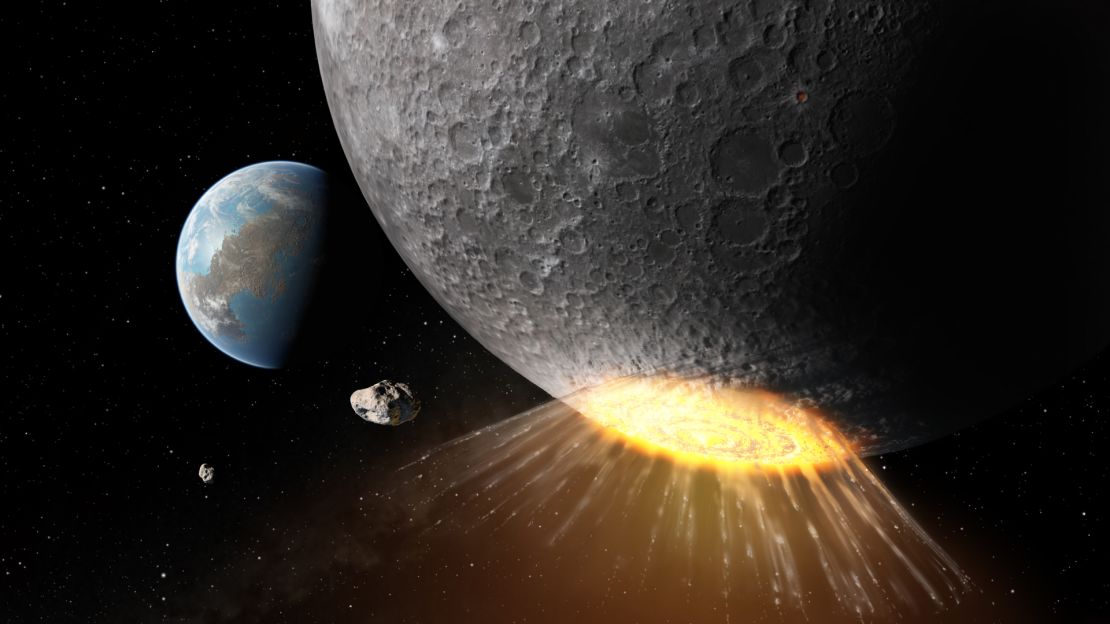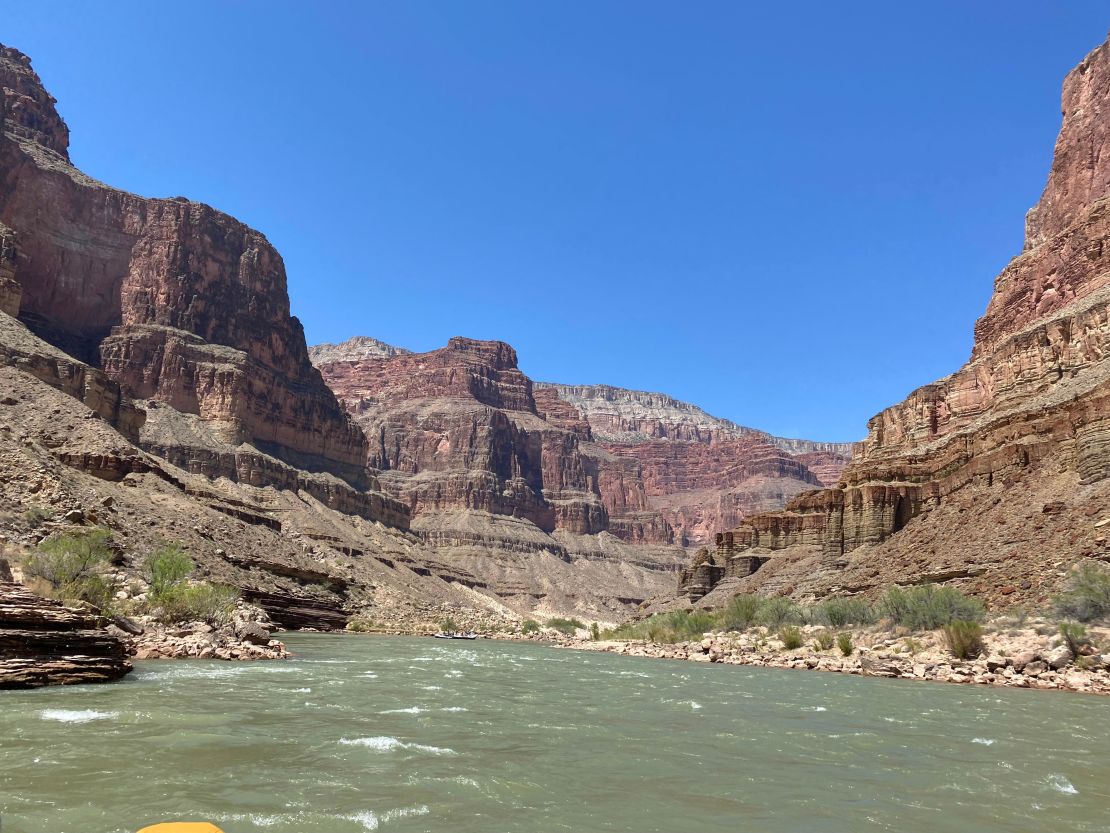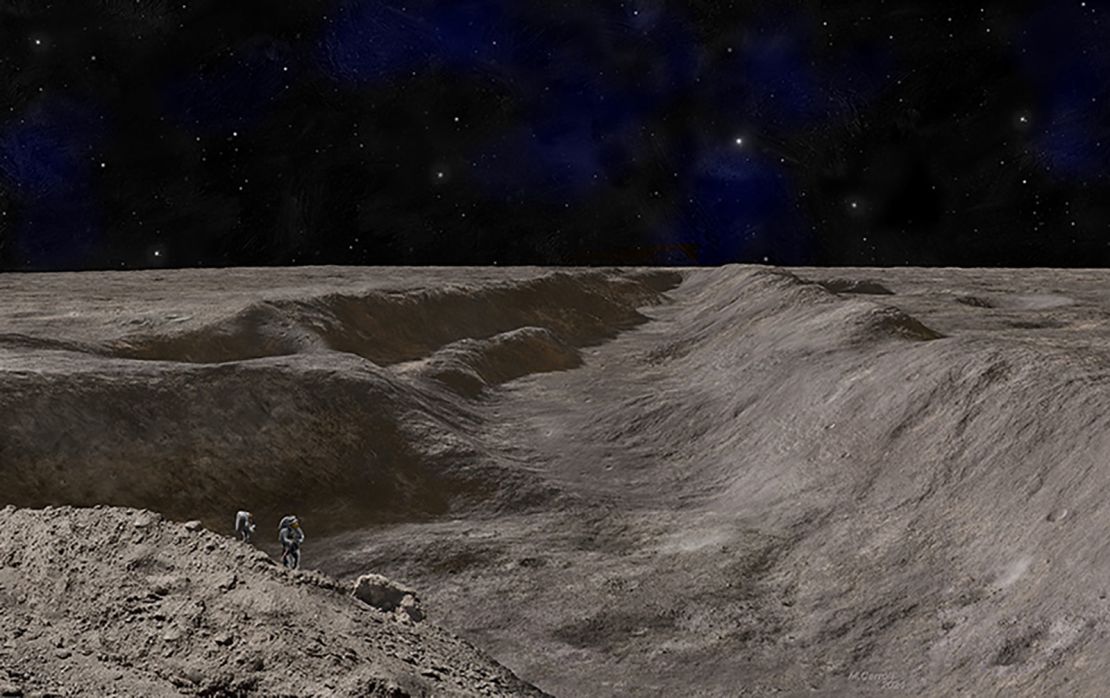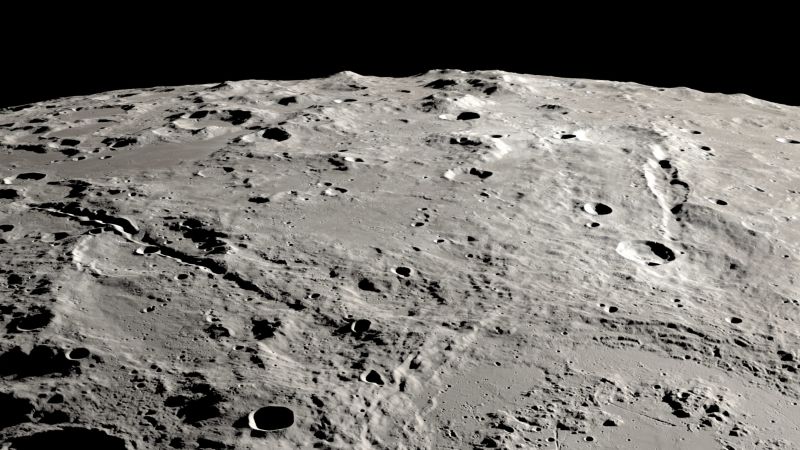Sign up for CNN’s Wonder Theory science newsletter. Explore the universe with news on fascinating discoveries, scientific advancements and more.
CNN
—
About 3.8 billion years ago, two massive canyons likely formed on the moon in a span of less than 10 minutes, according to new research.
The extraordinary formations, each comparable in size to Earth’s Grand Canyon, are hidden on the far side of the moon — the side that always faces away from Earth — near the lunar south pole, where NASA’s Artemis III mission aims to land humans in late 2026.
The lunar canyons are both part of the larger Schrödinger impact basin, where an object yet to be identified slammed into the moon billions of years ago. The colossal impact likely also led to the creation of the canyons as well, according to a new study published Tuesday in the journal Nature Communications.
The energy unleashed that created the canyons was 1,200 to 2,200 times more powerful than the nuclear explosion energy once planned to excavate a second Panama Canal, the study authors estimate.
Future missions could visit the basin and take rock samples to help scientists better understand the murky origins and history of the moon. Studying the moon also could reveal what conditions were like early on in the solar system as asteroids and other rocky debris collided with planets and moons.
“The record of early Solar System bombardment has been erased from the Earth,” said lead study author Dr. David Kring, principal scientist at the Lunar and Planetary Institute, an institute of the Universities Space Research Association, in an email. “It was destroyed by erosion, plate tectonics, and other geologic processes. If we want (to) understand how impact events affected the early Earth, we have to collect samples from places on the Moon like the Schrödinger basin and its canyons.”

Canyons and ravines created by streaks of rocky debris radiate from Schrödinger basin.
Lunar geologists have always known that the two canyons featured in the new study, called Vallis Schrödinger and Vallis Planck, were particularly large. The research team behind the latest report, however, was able to analyze images of the massive geological features using photos and elevation data captured by NASA’s Lunar Reconnaissance Orbiter, which has been circling the moon since 2009. The data allowed the team to construct maps of the region, including the basin and its surroundings.
The measurements showed these two canyons were similar in width and length to the Grand Canyon. Vallis Schrödinger is 168 miles (270 kilometers) long and 1.7 miles (2.7 kilometers) deep, and Vallis Planck is 174 miles (280 kilometers) long and 2.2 miles (3.5 kilometers) deep.
“I have trained students and astronauts in the vicinity of the Grand Canyon, and taken several river trips through the Grand Canyon, so I realized the Grand Canyon was an important way to help people understand the dramatic scale of the lunar landscape,” Kring said.
The spacecraft data also helped the researchers determine the distances along each canyon from the point of impact. The team used the distances in impact cratering calculations to figure out the velocities of the rocks that produced the canyons and the sizes of the material in those rock streams, Kring said.

The calculations enabled the researchers to fit together what they think happened 3.8 billion years ago during a time when asteroid and comets were bombarding Earth and the moon.
“Nearly four billion years ago, an asteroid or comet flew over the lunar south pole, brushed by the mountain summits of Malapert and Mouton, and hit the lunar surface,” Kring said. “The impact ejected high-energy streams of rock that carved two canyons … in less than 10 minutes.”
For comparison, it took 5 million to 6 million years for water to erode the landscape of Arizona to create the Grand Canyon.
The celestial object that plowed into the moon likely hit with a speed of more than 34,000 miles per hour (nearly 55,000 kilometers per hour). The impactor created the Schrödinger basin, which is nearly 200 miles (320 kilometers) wide, while also propelling debris that carved deep grooves leading away from the basin.
Then, the ejected debris that created the canyons likely soared over the lunar surface and then collided with it at speeds of about 2,237 miles per hour (3,600 kilometers per hour). These secondary impact craters formed the canyons, according to the study.
The energy of the impacts that created the canyons was on a gargantuan scale. The study authors estimate it was more than 700 times greater than the total yield of nuclear explosion tests conducted by the United States, the former Soviet Union and China. The energy of the blasts was also about 130 times more destructive than the energy in the worldwide stockpile of nuclear weapons, according to the study.
While many impact craters on Earth have long disappeared due to erosion and other natural factors, the moon’s craters can help researchers better understand what happened on Earth billions of years ago.
“The Schrödinger crater is similar in many regards to the dino-killing Chicxulub crater on Earth,” said study coauthor Gareth Collins, professor of planetary science at Imperial College London, in a statement. “By showing how Schrödinger’s (kilometers)-deep canyons were carved, this work has helped to illuminate how energetic the ejecta from these impacts can be.”

Noah Petro, NASA project scientist for both the Lunar Reconnaissance Orbiter and Artemis III, which aims to land humans on the moon for the first time since 1972, believes the paper presents a nice hypothesis for how the canyons were formed. Petro was not involved in the study.
“What’s presented in the paper is one hypothesis tying back to secondary cratering and these gouges that radiate far and wide away from them,” Petro said. “I think that the interesting thing the paper does is this connection back to a single point, and then hypothesizing what that means for the formation and the geometry of the formation of the basin. They’re using modern observations from a spacecraft that’s been orbiting the moon now for over 15 years to reconstruct an event that happened 3.8 billion years ago.
That’s always exciting because we’re peeling back the layers of time which are preserved so well for us on the moon.”
The south pole of the moon is filled with geologic mysteries that scientists are eager to explore, Petro said.
The Schrödinger impact basin, one of the younger, large impact craters on the moon, is within a few hundred kilometers of the moon’s oldest and largest impact basin, Petro said.
Schrödinger is located in the outer reaches of the South Pole–Aitken basin, which future crewed Artemis missions are planning to explore.
The South Pole–Aitken basin is estimated to be about 4.3 billion years old, but only rock samples will be able to prove whether that’s the case, Petro said.
“The first astronauts to walk at the south pole will potentially be walking on the oldest rocks that humans have ever explored,” he said.
The new study shows that the lunar debris excavated by the impacts that created the Schrödinger basin and its canyons radiated out asymmetrically, distributing it away from the lunar south pole, rather than burying the region. This means that any rocks collected by Artemis astronauts will provide glimpses of the earliest lunar history, Kring said.
Kring and his team plan to continue studying sites that could potentially be explored by future missions.

Team Draper’s lunar lander will aim to land in the Schrödinger Basin in 2026 under NASA’s Commercial Lunar Payload Services initiative, which is part of the Artemis program. The robotic mission will deliver seismometers to study tectonic activity within the lunar interior, among other scientific objectives.
“The far side of the moon is the realm of the explorer,” Petro said. “Whether it’s a robotic mission or an astronaut mission that goes to the moon, Schrödinger basin has never been seen or visited by a mission. We are deep in the exploration of these large craters because they are so unique. They’re giant backhoes that have dug up the lunar surface and exposed material from underneath, so they become very compelling targets.”
Kring sees value in collecting samples from the basin and canyons to help determine whether the estimated age of both is correct, as well as studying the ancient lunar material they helped bring to the surface.
“If an astronaut was able to collect samples from the rims of the canyons, they would collect samples from up to 3 kilometers (1.9 miles) beneath the surface,” he said.
And the astronauts would be able to see incredible views.
“The splendor of the canyons is so dramatic that if exposed on Earth, they would be national or international parks,” Kring said.

